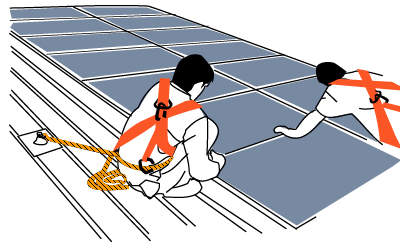
Read our simple guide on what to expect if you’re planning on getting solar panels installed. Find out what to look for, who to talk to and how to get a deal that suits you.

Once you’ve decided that you want to go solar, what’s next? There are countless different solar installers across Australia, all with a wide range of marketing claims, deals and certifications that won’t mean a thing to you if you’re looking for the first time. Below’s a guide to help you get started.
Decide what you need
The first step is to work out how much solar energy you want to collect. To do this, you need to know roughly how much electricity you consume on average – usually represented by kilowatt hours (kWh) per day in your power bill. Then you need to find out how much daily sun you can expect over a year, also known as insolation or sun-hours. With a kWh target and knowing how much energy you can expect daily on average, you can determine what size system you’ll need.
Find an installer
The next step is to find a reputable supplier who will offer you a system of the size you need for the right price. This can be more difficult than it sounds, because there’s a surprising amount of variation in the industry and bold claims about the performance of some systems can be hard to refute. Getting a qualified designer and installer is highly recommended for many reasons – primary among them being that this is necessary to apply for government rebates.
There is a national accreditation scheme run by the Clean Energy Council, who list all of their qualified installers on their website, and this is an ideal place to start looking. These companies are able to design, supply and install photovoltaic (PV) systems. They’re also able to handle any grid connection, which you’ll need if you’re hoping to sell electricity back to your energy retailer. Call some local suppliers and get some quotes, then proceed with the one you feel most comfortable with. Keep in mind things like warranty support; you will want a company that can back up its product in twenty years’ time.
System certification
All components of your system must be compliant with the Australian Standard AS4777 – Grid connection of energy systems via inverters and AS3100 – Approval and test specification – General requirements for electrical equipment in order to qualify for any rebates or feed-in tarrifs (FiTs). The CEC maintains an updated list of all approved panels and inverters on their website, and it’s best to choose your components from this. Other international certification marks may not meet Australian Standards, despite bearing official-looking stamps of quality – so be wary!
Rebates and Feed-in Tariffs (FiTs)
There are currently three government-run schemes which can lower the cost of your system and potentially, your electricity bills. They are:
- Solar Credits
- STCs (Small-scale Technology Certificates)
- Feed-in tariffs (FiTs)
Applying for these credits and rebates can be a minefield of red tape with regulations changing from state to state, but the CEC has published a clear guide explaining what’s available to you. This information is important to be across to ensure that you’re not stuck waiting months for tariffs to start winding back the meter. Many suppliers will take care of the paperwork on your behalf, offering the rebate back as a discount on the system.
You can apply for the rebates yourself, but this can be quite labour intensive so you may want to choose this option if you don’t have the time to set aside.
For further information, download the Clean Energy Council’s consumer guide to solar installations in Australia.





